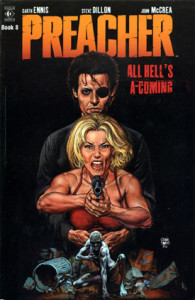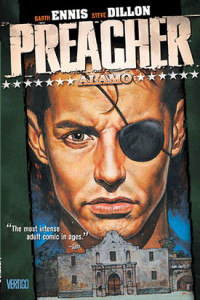The final two volumes of Garth Ennis and Steve Dillon’s epic Preacher, All Hell’s A-Coming and Alamo, bring us back to the Quest.
 In All Hell’s A-Coming, Jesse and Tulip (and Cassidy) are reunited. It hasn’t been an easy time for either of them, but after the tears and recriminations (of which there are amazingly few), they’re back in each other’s arms and Jesse is ready to resume his search for God. We’re also brought up to date on the status of Herr Starr and the Grail, as well as Arseface’s rise and fall as a rock star — all accomplished before the release of his first album.
In All Hell’s A-Coming, Jesse and Tulip (and Cassidy) are reunited. It hasn’t been an easy time for either of them, but after the tears and recriminations (of which there are amazingly few), they’re back in each other’s arms and Jesse is ready to resume his search for God. We’re also brought up to date on the status of Herr Starr and the Grail, as well as Arseface’s rise and fall as a rock star — all accomplished before the release of his first album.
Alamo brings us the final confrontations, although with a twist — remember the Saint of Killers? He’s still around, and after a heart-felt talk with Jesse, he has his own reasons to find God.
The books become, to a noticeable degree, even more cinematic than they have been. We’re faced with quick cuts between scenes and story lines, with installments sometimes lasting no more than a page. It works with the pacing of the story, which builds momentum toward the ultimate climax.
 And we’re dealing with a vastly expanded depth of character and story. Ennis has spent time in the previous volume letting us get into Jesse’s head, a journey that continues here. We’ve also got back story on Tulip and Cassidy and their time together. It wasn’t pretty, but then, Cassidy’s not the most together guy you’ve ever met.
And we’re dealing with a vastly expanded depth of character and story. Ennis has spent time in the previous volume letting us get into Jesse’s head, a journey that continues here. We’ve also got back story on Tulip and Cassidy and their time together. It wasn’t pretty, but then, Cassidy’s not the most together guy you’ve ever met.
Ennis hasn’t spared us the grotesqueries and the gore that have been an integral part of the story. It’s sometimes a little heavy-handed, but it makes his point, I think: outside the story of Jesse Custer and his quest, this is what America has become. It’s not a completely black picture: we have bright moments, such as Sally, the bag lady who fills Jesse in on Cassidy’s life before, who takes her life very matter-of-factly and just deals with it; or Amy, Tulip’s friend from college who, in spite of being born rich, is just a genuinely good person; or Lorie, who sees Arsesface for who he is, and not what he looks like. But the overview is pretty bleak. (I’m sure if one wanted to spend the time, one could draw pretty strong parallels between charactes in this story and real-life people or organizations — say, for example, Herr Starr, head of a shadowy multinational organization that has presidents at its beck and call.) It’s satire of a particularly bloodthirsty sort.
It’s a rich story, all told — Ennis has pulled in all the elements — vampires, Vietnam-era war stories, the classic Western, and too many others to list — into a classic quest story populated by some of the most engaging characters — and some of the most repellent — ever to grace the graphic medium.
(Vertigo/DC Comics, 2000, 2001) Collects Preacher #51-58 and Preacher: Tall in the Saddle and Preacher #59-66.
